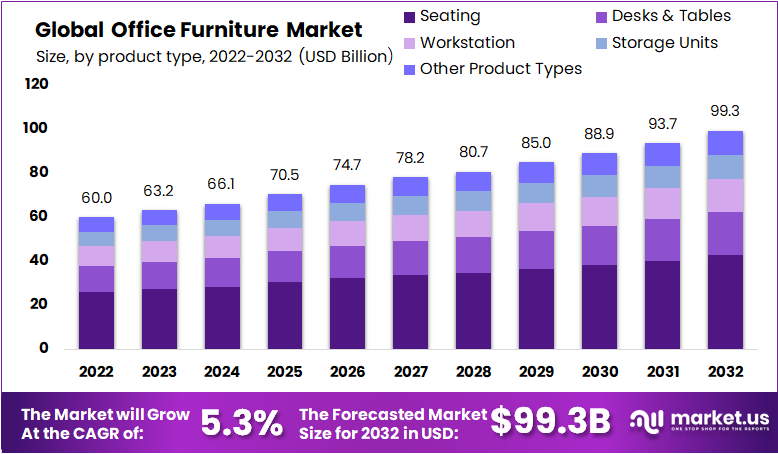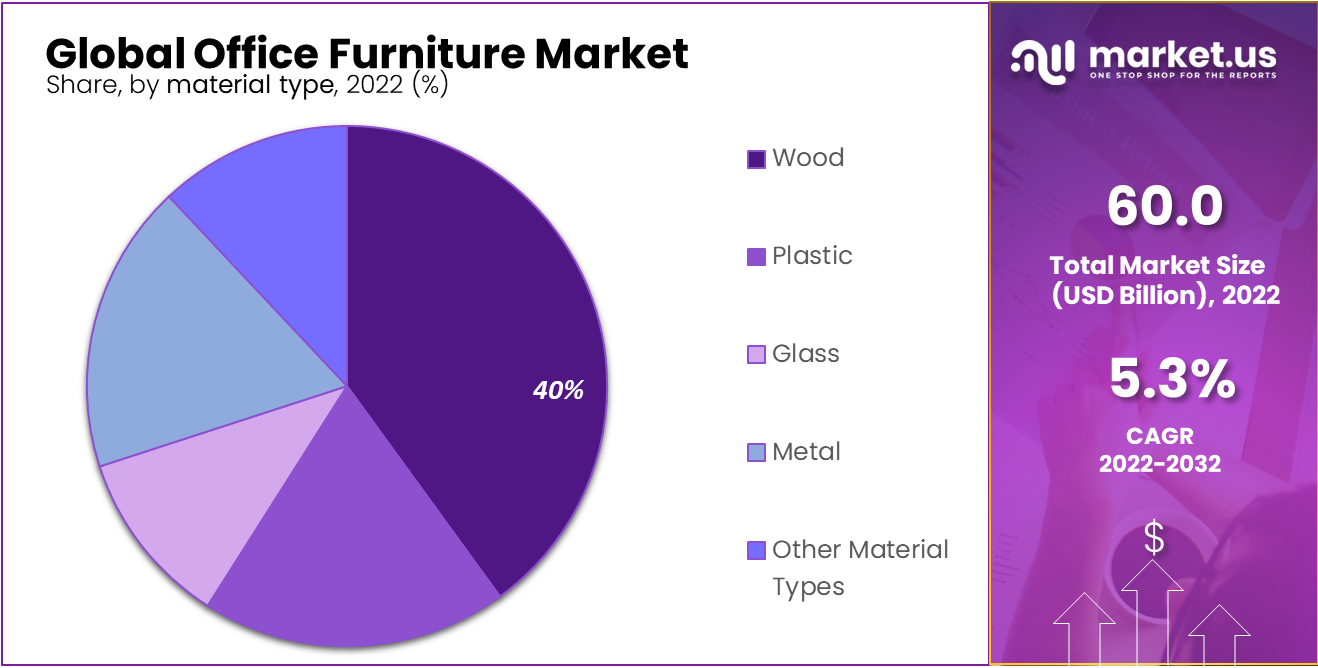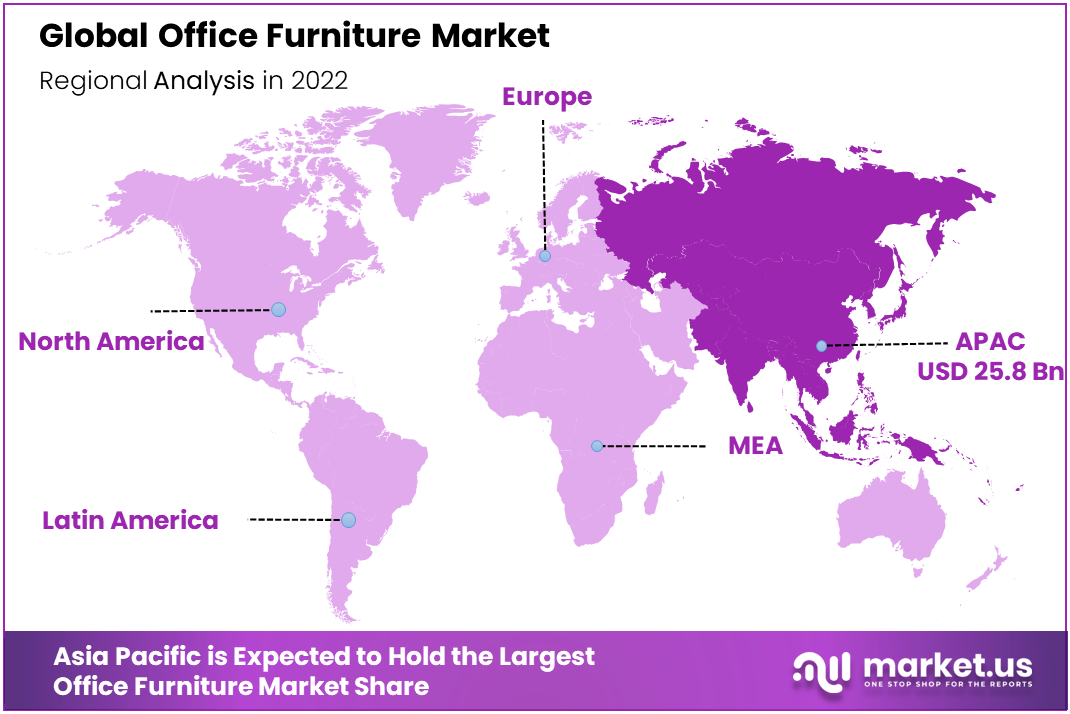Global Office Furniture Market Size, Trades, COVID-19 Impact & Growth By Product Type (Storage Units, Seating, Desks & Tables, Workstation, and Other Product Types), By Material Type (Metal, Wood, Plastic, Glass, and Other Material Types), By Price Range (Premium, Economic, and Medium), By Distribution Channel (Online Retail Stores and Offline Retail Stores), By Region and Companies - Industry Segment Outlook, Market Assessment, Competition Scenario, Trends, and Forecast 2023-2032
- Published date: Sep 2023
- Report ID: 32296
- Number of Pages: 215
- Format:
- keyboard_arrow_up
Quick Navigation
- Report Overview
- Driving Factors
- Restraining Factors
- Growth Opportunities
- Latest Trends
- Product Type Analysis
- Material Type
- Price Range Analysis
- Distribution Channel Analysis
- Global Office Furniture Market Segments Includes:
- Regional Analysis
- Key Regions and Countries Covered in this Report:
- Market Share & Key Players Analysis:
- Report Scope:
Report Overview
The Global Office Furniture Market size is expected to be worth around USD 99.3 Billion by 2032 from USD 60 Billion in 2022, growing at a CAGR of 5.30% during the forecast period from 2023 to 2032.
Office furniture plays a pivotal role in shaping the work environment, enhancing productivity, and reflecting the identity of a company. The design, functionality, as well as quality of office furniture not only impact the physical comfort of employees but also contribute to the overall aesthetics and functionality of the office space.

Actual Numbers Might Vary in the Final Report
Driving Factors
Economic Growth, Technology Integration, and Flexible Office Arrangements Drive Global Office Furniture Market
Economic growth in different regions directly impacts the office furniture market. During periods of economic expansion, businesses often expand their operations, open new offices, or renovate existing ones. This results in an increased demand for office furniture to furnish these spaces. Emerging markets, in particular, witness a surge in office furniture demand as they undergo urbanization and industrialization.
The integration of technology into office furniture is a significant driver. Modern workplaces are embracing smart furniture solutions that enhance productivity and comfort. For instance, adjustable desks with electronic height controls, ergonomic chairs with posture-correcting sensors, and collaborative furniture with integrated audiovisual systems are gaining popularity as businesses seek to create high-tech work environments.
The rise of co-working spaces and flexible office arrangements has fueled the demand for adaptable office furniture. Modular and reconfigurable furniture allows businesses to adjust their office layouts quickly and efficiently to meet changing needs. This flexibility is essential for companies looking to optimize their office spaces.
Restraining Factors
Wood, metal, plastic, as well as other raw materials used in office furniture production, remain highly unstable due to factors such as weather-induced deforestation of forests. Such high costs make office furniture less affordable for businesses, which could eventually reduce demand in the market.
Advanced office furniture, such as tech-charging furniture and multi-touch tables, tend to be prohibitively expensive due to the use of new technologies and materials in their production, placing it out of reach for many businesses.
Growth Opportunities
Companies are increasingly adopting flexible office spaces that allow employees to work in various settings within the office. This trend requires adaptable furniture that can easily transform to accommodate different work arrangements, from collaborative workstations to private workspaces. Sustainability is becoming a paramount concern in the furniture industry.
Consumers and businesses alike are increasingly looking for eco-friendly, recyclable, and energy-efficient office furniture solutions. Investing in sustainable materials, production processes, and certifications can set companies apart in this competitive market while contributing to a greener future.
Latest Trends
Prioritizing Ergonomics and Comfort in Office Furniture Design for Enhanced Productivity and Well-Being
Ergonomics focuses on designing furniture that supports the natural posture and movements of the human body. In office furniture, this translates to chairs with adjustable features like height, armrests, and lumbar support. Comfort is a key consideration because comfortable employees tend to be more productive and experience fewer health issues related to poor posture.
Product Type Analysis
Seating Segment Dominate Global Office Furniture Market
Based on product type, the global office furniture market is segmented into storage units, seating, desks and tables, workstations, and other product types. The seating segment is the dominant segment in the global office furniture market, accounting for the largest share of 43% in the market.
The primary driver for the seating segment is the growing awareness and importance of ergonomic office furniture. With increasing concerns about employee health and comfort, ergonomic chairs have gained immense popularity. They offer features like lumbar support, adjustable armrests, and seat height, which enhance comfort and reduce the risk of musculoskeletal problems.
The desks & tables segment is the second-largest segment in the global office furniture market. The efficient utilization of office space is crucial for companies. Compact and multifunctional desk designs help maximize workspace, making them a driver for this segment.
Material Type
Wood Segment is Dominant in the Market
Based on material type, the global office furniture market is segmented into metal, wood, plastic, glass, and other material types. The wood segment is the dominant segment in the global office furniture market, accounting for a market share of around 40% in 2022. Wooden office furniture has long been known for its durability and longevity, making it a cost-effective choice for businesses that prioritize long-term value over cost.
Furthermore, with rising environmental concerns coming into focus more frequently now, sustainable wood sources have become more significant drivers. More consumers and businesses prioritize eco-friendly furnishings, which has led manufacturers to utilize certified sustainable sources.
Price Range Analysis
Economic Segment Dominates This Market
Based on the price range, the market is classified into premium, economic, and medium. Based on the price range, the economic segment is the dominant segment in this market, with the largest market revenue share of 37%.
Economic office furniture is more affordable for businesses, especially small and medium-sized enterprises (SMEs) and startups. In a highly competitive business environment, cost savings are a significant driver. Companies prefer economical furniture options that allow them to allocate resources to other critical areas of their operations.
Distribution Channel Analysis
Based on the distribution channel, the global office furniture market is segmented into online retail stores and offline retail stores. The offline distribution channel is the dominant segment in the global office furniture market, accounting for the largest market share of 60%. Offline retail stores provide customers with a hands-on, physical shopping experience.
Buyers can touch, feel, and test the furniture, which is particularly important for office furniture, as comfort and functionality are crucial considerations. Being able to see and try out items before purchase instills confidence in buyers. Many businesses require bulk purchases of office furniture. Offline stores often offer discounts and packages for large orders, making it financially advantageous for commercial buyers.

Global Office Furniture Market Segments Includes:
By Product Type
- Storage Units
- Seating
- Desks & Tables
- Workstation
- Other Product Types
By Material Type
- Metal
- Wood
- Plastic
- Glass
- Other Material Types
By Price Range
- Premium
- Economic
- Medium
By Distribution Channel
- Online Retail Stores
- Offline Retail Stores
Regional Analysis
Asia Pacific Dominates the Global Commercial Vehicles Market
Asia Pacific is the largest market for office furniture, accounting for the largest share of 43% in the global market. Countries like China and India have witnessed phenomenal economic growth over the last couple of decades. This has led to increased business activities and, consequently, greater demand for office spaces and office furniture.
The region has become a magnet for FDI, particularly in sectors like IT, manufacturing, and services. These investments naturally require physical infrastructure, including high-quality office furniture. Cities like Bangalore and Hyderabad in India, Shenzhen and Beijing in China are becoming global tech hubs. The expansion of these sectors requires a large amount of furnished office space, boosting the demand for office furniture.
North America is the second-leading region in the global office furniture market. North America has one of the highest GDPs in the world, and the consumer purchasing power is also significantly high. This financial stability allows for substantial investment in quality office furniture, both for corporate spaces and home offices.
The robust commercial real estate market in cities like New York, San Francisco, and Toronto supports the continuous demand for office furniture, from conventional desks and chairs to more ergonomic and specialized furniture options.

Key Regions and Countries Covered in this Report:
- North America
- The US
- Canada
- Europe
- Germany
- France
- The UK
- Italy
- Spain
- Russia & CIS
- Rest of Europe
- APAC
- China
- Japan
- South Korea
- India
- ASIAN
- Rest of APAC
- Latin America
- Brazil
- Mexico
- Rest of Latin America
- Middle East & Africa
- GCC
- South Africa
- United Arab Emirates
- Rest of the Middle East & Africa
The key players in the global office furniture market employ a variety of strategies to sustain and expand their presence in this highly competitive environment. Companies are focusing heavily on ergonomic furniture that is tailored to enhance user comfort and minimize health risks, such as musculoskeletal problems. Several key players are also integrating smart technology into furniture. This includes sit/stand desks, smart chairs that adapt to your posture, and furniture with built-in wireless charging points.
Market Key Players:
- Steelcase Inc.
- Okamura Corporation
- HNI Corporation
- Herman Miller Inc.
- Haworth Inc.
- Knoll Inc.
- KOKUYO Co., Ltd.
- Meridian Office Group
- Kimball International Inc.
- 9to5 Seating
- Berco Designs
- Hooker Furniture
- La-Z-Boy
- Vitra
- Kinnarps AB
- Sedus Stoll AG
- Other Key Players
Recent Developments:
- In February 2023, Okamura Corporation unveiled the opening of their manufacturing plant in Vietnam, expected to produce up to 1 million pieces of office furniture annually and will help Okamura to meet the growing demand for office furniture in Southeast Asia.
- In March 2023, HNI Corporation acquired Kimball International for $1.8 billion, creating an industry leader with strong U.S. and European presence.
Report Scope:
Report Features Description Market Value (2022) US$ 60 Billion Forecast Revenue (2032) US$ 99.3 Billion CAGR (2023-2032) 5.3% Base Year for Estimation 2022 Historic Period 2016-2022 Forecast Period 2023-2032 Report Coverage Revenue Forecast, Market Dynamics, COVID-19 Impact, Competitive Landscape, Recent Developments Segments Covered By Product Type: Storage Units, Seating, Desks and tables, Workstation, and Other Product Types; By Material Type: Metal, Wood, Plastic, Glass, and Other Material Types; By Price Range: Premium, Economic, and Medium; By Distribution Channel: Online Retail Stores and Offline Retail Stores. Regional Analysis North America: The US and Canada; Europe: Germany, France, The UK, Italy, Spain, Russia & CIS, and the Rest of Europe; APAC: China, Japan, South Korea, India, ASEAN, and the Rest of APAC; Latin America: Brazil, Mexico, and Rest of Latin America; Middle East & Africa: GCC, South Africa, United Arab Emirates, and Rest of Middle East & Africa. Competitive Landscape Steelcase Inc., Okamura Corporation, HNI Corporation, Herman Miller Inc., Haworth Inc., Knoll Inc., KOKUYO Co., Ltd., Meridian Office Group, Kimball International Inc., 9to5 Seating, Berco Designs, Hooker Furniture, La-Z-Boy, Vitra, Kinnarps AB, Sedus Stoll AG, and Other Key Players. Customization Scope Customization for segments, region/country-level will be provided. Moreover, additional customization can be done based on the requirements. Purchase Options We have three licenses to opt for: Single User License, Multi-User license (Up to 5 Users), Corporate Use License (Unlimited User and Printable PDF) Frequently Asked Questions (FAQ)
What is the Office Furniture Market Size in the Year 2022?The Office Furniture Market size was USD 60 Billion in 2022, growing at a CAGR of 5.30% during the forecast period.
What is the Office Furniture Market CAGR Estimated During the Forecast Period 2023-2032?The Office Furniture Market size is expected to grow at a CAGR of 5.30% during the forecast period 2023-2032.
What is the Office Furniture Market Size Estimated During the Year 2023-2032?The Office Furniture Market size is expected to be worth around USD 99.3 Billion by 2032 during the forecast period.

- Steelcase Inc.
- Okamura Corporation
- HNI Corporation
- Herman Miller Inc.
- Haworth Inc.
- Knoll Inc.
- KOKUYO Co., Ltd.
- Meridian Office Group
- Kimball International Inc.
- 9to5 Seating
- Berco Designs
- Hooker Furniture
- La-Z-Boy
- Vitra
- Kinnarps AB
- Sedus Stoll AG
- Other Key Players
- settingsSettings
Our Clients
| Single User $4,599 $3,499 USD / per unit save 24% | Multi User $5,999 $4,299 USD / per unit save 28% | Corporate User $7,299 $4,999 USD / per unit save 32% | |
|---|---|---|---|
| e-Access | |||
| Report Library Access | |||
| Data Set (Excel) | |||
| Company Profile Library Access | |||
| Interactive Dashboard | |||
| Free Custumization | No | up to 10 hrs work | up to 30 hrs work |
| Accessibility | 1 User | 2-5 User | Unlimited |
| Analyst Support | up to 20 hrs | up to 40 hrs | up to 50 hrs |
| Benefit | Up to 20% off on next purchase | Up to 25% off on next purchase | Up to 30% off on next purchase |
| Buy Now ($ 3,499) | Buy Now ($ 4,299) | Buy Now ($ 4,999) |












